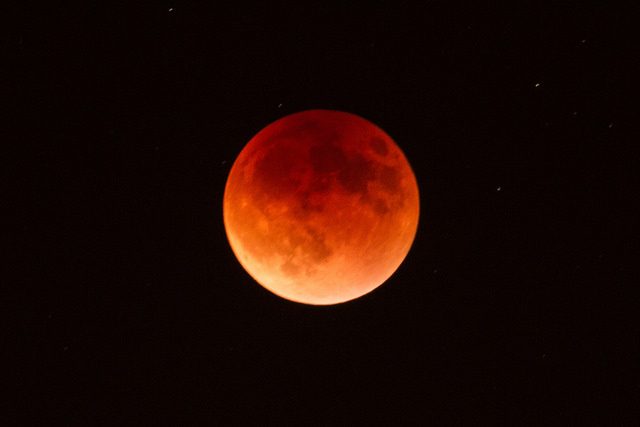Unlike the solar eclipse, an eclipse of the moon occurs when the moon lingers in the shadows of the earth. The sun for such an occurrence would be on the opposite side of the earth.
The arrangement must be in such a way that these three celestial bodies form a line of three collinear points, or at least very closely align with each other. However, the significant determinant for an occurrence of a Lunar Eclipse is the full moon, i.e. an eclipse only occurs on nights when the moon is full.
Umbra and Penumbra are the names
The duration of a lunar eclipse is dependent on the distance of the moon from the earth. The farther the moon is, the longer the eclipse lasts.
Following are the primary terminologies which describe the types of Lunar Eclipse:
- Total Lunar Eclipse
In a total lunar eclipse, the moon completely falls under the Umbra. This leads to the seldom occurring Central Lunar Eclipse, which happens when the moon passes the center of the Earth’s Umbra. - Partial Lunar Eclipse
As opposed to Total Lunar Eclipse, a partial one occurs when the moon is partially inside the earth’s shadow. - Penumbral Eclipse
Same as with the eclipse occurring when the moon is inside the umbra, the moon eclipses totally as well partially when inside the penumbra as well. The Total Penumbral eclipse only occurs when the moon is completely inside the Penumbra.
Blood Moon
The earth’s atmosphere consists of dust, gasses, and water droplets. The sunlight actually consists of seven different colors, which are visible during a rainbow. These colors range from Violet with the shortest wavelength to Red with the longest wavelength. As the sunlight enters the atmosphere, the color with the shortest wavelength scatters the most, while the color with the longest wavelength scatters the least; hence, the remaining reddish colors finally refract to the moon. This is how the moon appears to be red in color, and the phenomenon is informally called as a Blood Moon.
Selenelion
The lunar eclipse is linked with another remarkable visual delight. Due to the refraction of light through the earth’s atmosphere, the moon, and the sun appear to be higher than they actually are. This leads to the appearance of a horizontal eclipse when both, the sun and the eclipsed moon could be seen on the opposite sides of the horizon at the same time. Horizontal eclipse is also known as a selenelion.
Christopher Columbus and Lunar Eclipse
In the year 1504, Christopher Columbus had a rather unconventional use of a Lunar Eclipse that saved his life. Columbus, who was among the first explorers of Americas was also able to survive along with his crew for over a year in an inarguably unfriendly territory.
The native population around the northern coast of Jamaica had become hostile to Columbus’ crew and would no longer provide any food for their survival. The Italian explorer, in a desperate attempt to save himself deployed a technique not many could have thought. He took refuge in a book written by Regiomontanus. The German mathematician and astronomer had prepared a lunar calendar on the basis of the Earth-centered model of the solar system. With the book’s help, Columbus predicted a lunar eclipse and fooled the natives in believing that the moon had disappeared from the sky as a result of them not helping the crew. The very next day the inhabitants of the region complied with his demands.
Since time immemorial, the humble lunar eclipse has also been associated with myths and legends in various cultures throughout the world. While some consider it good and others bad, there is no denying the fact that a lunar eclipse has always fascinated the human mind.
Thy shadow, Earth, from Pole to Central Sea,
Now steals along upon the Moon’s meek shine
In even monochrome and curving line
Of imperturbable serenity
-Thomas Hardy
As the famous English novelist states, a lunar eclipse is no less than perfect showmanship of nature.
By Abdullah Sultan Usmani
Edited by Cathy Milne
Sources:
Time and Date: What is a Total Lunar Eclipse?
Time and Date: Why does the Moon turn Red during a Lunar Eclipse
Mr. Eclipse: Lunar Eclipses for Beginners
Science News: The Eclipse that saved Columbus
Writing and Ruminating: At a Lunar Eclipse by Thomas Hardy
Featured and Top Image Courtesy of Bryan Jones’ Flickr Page – Creative Commons License
First Inline Image By Sagredo Courtesy of Wikimedia Commons – Public Domain License








